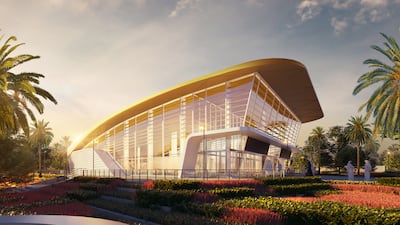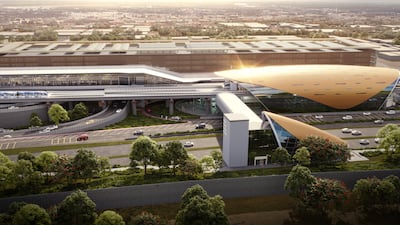Dubai's plan to build three road tunnels as part of a Dh633 million ($172 million) project to cut congestion highlights the emirate’s modernising ambitions, experts told The National.
The tunnels are part of the Al Mustaqbal Street development project from Zabeel Palace Street to Financial Centre Street and will together cater for up to 9,000 vehicles an hour.
The upgrade comes as the emirate’s population approaches four million and, according to official analysis, looks set to reach 5.8 million by 2040.
Alan Vardy, professor of civil engineering at the University of Dundee, said “most major cities” have road tunnels, with plenty examples in desert regions.
Dubai itself already has them, notably Al Shindagha Tunnel under Dubai Creek, which opened almost 50 years ago. Early last year Saudi Arabia opened its longest road tunnel, the Abu Bakr Al Siddiq, which stretches for 2.4km.
Deeper and down
Prof Vardy said that, while in desert areas there may be loose sand on the surface, further down there is “all sorts of different geology” but this is not likely to be an obstacle.
Engineers may craft a “cut and cover” tunnel, which involves digging a deep trench, walls (typically filled with concrete) and a concrete bottom, before they “put a top lid on it”.
“You retain the space above it to do whatever you might want: some cities you put a park; some cities you have a walkway; some cities you have buildings,” he said.
“The ground on top of it is completely uninfluenced by the fact you have this thing underneath the surface. That’s the reason for putting it underneath – you put it out of the way.”
A complication of building tunnels in cities is, he said, the existence of service infrastructure underground, such as water or gas pipes. A main sewer for a major city will typically measure more than 10 metres in diameter and this will probably be “a reasonable distance down”, Prof Vardy said.
“These things, they’re really quite deep,” he said. “You have got to get underneath them or work your way around them. The tunnel is not a straight line – not tight corners but it’s got to move around. Or you move the big gas pipes or water pipes, but that’s expensive.”
To avoid existing infrastructure, tunnels may have to be built tens of metres below the surface.
While complications such as these can confound, with some tunnels “more difficult than others” from an engineering point of view, Prof Vardy said hurdles can be overcome.
“Sometimes the challenge is very big but technically you can always manage it,” he said. “If a city wants it enough and is prepared to pay for it, you can do it.”
Effect on traffic?
The development project will also include a 450-metre bridge for traffic from Dubai World Trade Centre to the Zabeel Palace Street and Al Mustaqbal Street intersection, while part of Al Mustaqbal Street will be widened from three lanes to four in both directions.
The work is not focused only on motorists, as pedestrian paths will be improved and a cycling track installed.
Analysts are concerned, however, that increasing road capacity will cause the amount of traffic to grow, a phenomenon, known as induced demand, that has been seen elsewhere.
“Usually, the more roads you build, the more cars you attract, and eventually, traffic congestion follows,” said Dr Alexandra Gomes, a research fellow at the London School of Economics, who has written about Gulf cities.
“Roads also divide the city, disrupting connectivity and walkability. With roads and cars come parking spaces, which further contribute to this spatial disconnection, even if pedestrian walkways are added here and there.”
Long-term planning
Ensuring people’s basic needs and services are accessible by walking or travelling by bicycle can reduce dependence on cars, Dr Gomes said.
Thomas Edelmann, founder and managing director of Road Safety UAE, said the newly announced work was “another great project” that “will fix the situation for a certain amount of time” until traffic volumes grow again.
Looking longer term, he said it was important to reduce dependence on road travel, which meant a need for “alternative means of mass transportation”.
“I think the only real alternative is rail-bound mass transport systems. We do have the Dubai Metro as a flagship project in the Middle East,” he said.
"The strategic thinking must prevail and Dubai must learn from other cities that do have a very well-functioning rail-bound mass transportation system.”
The emirate has previously announced upgrades to its public transport infrastructure, including the addition of Dubai Metro’s Blue Line, which will complement the existing Red Line and Green Line and is scheduled to open in 2029.
In a separate announcement, on Monday the Ministry of Energy and Infrastructure unveiled a Dh750 million ($204 million) expansion of Emirates Road, with the number of lanes increasing from three to five on a 25km stretch between Sharjah and Umm Al Quwain.
In survey details released this week, Road Safety UAE and Al Wathba Insurance reported 47 per cent of UAE road users felt frustrated, annoyed, very stressed or anxious when stuck in traffic, although 5 per cent said they enjoyed the time.
About 37 per cent of motorists said they “very often” saw rude or aggressive behaviour from other motorists in traffic jams, while 45 per cent occasionally do.
Research findings released two weeks ago by the same organisations indicated 86 per cent of UAE motorists typically experience traffic congestion, while four out of five think the problem is worse now than a year ago.
Dubai Metro's Blue Line - in pictures
Results:
Men's wheelchair 800m T34: 1. Walid Ktila (TUN) 1.44.79; 2. Mohammed Al Hammadi (UAE) 1.45.88; 3. Isaac Towers (GBR) 1.46.46.
The specs
Engine: 3.0-litre twin-turbo flat-six
Power: 480hp at 6,500rpm
Torque: 570Nm from 2,300-5,000rpm
Transmission: 8-speed dual-clutch auto
Fuel consumption: 10.4L/100km
Price: from Dh547,600
On sale: now
UAE currency: the story behind the money in your pockets
The%20Boy%20and%20the%20Heron
%3Cp%3E%3Cstrong%3EDirector%3A%C2%A0%3C%2Fstrong%3EHayao%20Miyazaki%3C%2Fp%3E%0A%3Cp%3E%3Cstrong%3EStarring%3A%3C%2Fstrong%3E%C2%A0Soma%20Santoki%2C%20Masaki%20Suda%2C%20Ko%20Shibasaki%3C%2Fp%3E%0A%3Cp%3E%3Cstrong%3ERating%3A%20%3C%2Fstrong%3E5%2F5%3C%2Fp%3E%0A
Guide to intelligent investing
Investing success often hinges on discipline and perspective. As markets fluctuate, remember these guiding principles:
- Stay invested: Time in the market, not timing the market, is critical to long-term gains.
- Rational thinking: Breathe and avoid emotional decision-making; let logic and planning guide your actions.
- Strategic patience: Understand why you’re investing and allow time for your strategies to unfold.
Scoreline
Chelsea 1
Azpilicueta (36')
West Ham United 1
Hernandez (73')
Generation Start-up: Awok company profile
Started: 2013
Founder: Ulugbek Yuldashev
Sector: e-commerce
Size: 600 plus
Stage: still in talks with VCs
Principal Investors: self-financed by founder
Abu Dhabi Sustainability Week
Turkish Ladies
Various artists, Sony Music Turkey
RESULTS
2pm: Handicap (PA) Dh40,000 (Dirt) 1,000m
Winner: AF Mozhell, Saif Al Balushi (jockey), Khalifa Al Neyadi (trainer)
2.30pm: Maiden (PA) Dh40,000 (D) 2,000m
Winner: Majdi, Szczepan Mazur, Abdallah Al Hammadi.
3pm: Handicap (PA) Dh40,000 (D) 1,700m
Winner: AF Athabeh, Tadhg O’Shea, Ernst Oertel.
3.30pm: Handicap (PA) Dh40,000 (D) 1,700m
Winner: AF Eshaar, Bernardo Pinheiro, Khalifa Al Neyadi
4pm: Gulf Cup presented by Longines Prestige (PA) Dh150,000 (D) 1,700m
Winner: Al Roba’a Al Khali, Al Moatasem Al Balushi, Younis Al Kalbani
4.30pm: Handicap (TB) Dh40,000 (D) 1,200m
Winner: Apolo Kid, Antonio Fresu, Musabah Al Muahiri
CONCRETE COWBOY
Directed by: Ricky Staub
Starring: Idris Elba, Caleb McLaughlin, Jharrel Jerome
3.5/5 stars
Company%20profile
%3Cp%3E%3Cstrong%3ECompany%20name%3A%20%3C%2Fstrong%3EHakbah%0D%3Cbr%3E%3Cstrong%3EStarted%3A%20%3C%2Fstrong%3E2018%0D%3Cbr%3E%3Cstrong%3EFounder%3A%20%3C%2Fstrong%3ENaif%20AbuSaida%0D%3Cbr%3E%3Cstrong%3EBased%3A%20%3C%2Fstrong%3ESaudi%20Arabia%0D%3Cbr%3E%3Cstrong%3ESector%3A%20%3C%2Fstrong%3EFinTech%0D%3Cbr%3E%3Cstrong%3ECurrent%20number%20of%20staff%3A%20%3C%2Fstrong%3E22%20%0D%3Cbr%3E%3Cstrong%3EInitial%20investment%3A%20%3C%2Fstrong%3E%24200%2C000%0D%3Cbr%3E%3Cstrong%3EInvestment%20stage%3A%20%3C%2Fstrong%3Epre-Series%20A%0D%3Cbr%3E%3Cstrong%3EInvestors%3A%20%3C%2Fstrong%3EGlobal%20Ventures%20and%20Aditum%20Investment%20Management%0D%3Cbr%3E%3Cbr%3E%3C%2Fp%3E%0A
UAE%20v%20West%20Indies
%3Cp%3EFirst%20ODI%20-%20Sunday%2C%20June%204%20%0D%3Cbr%3ESecond%20ODI%20-%20Tuesday%2C%20June%206%20%0D%3Cbr%3EThird%20ODI%20-%20Friday%2C%20June%209%26nbsp%3B%3C%2Fp%3E%0A%3Cp%3EMatches%20at%20Sharjah%20Cricket%20Stadium.%20All%20games%20start%20at%204.30pm%0D%3Cbr%3E%0D%3Cbr%3E%3Cstrong%3EUAE%20squad%3C%2Fstrong%3E%0D%3Cbr%3EMuhammad%20Waseem%20(captain)%2C%20Aayan%20Khan%2C%20Adithya%20Shetty%2C%20Ali%20Naseer%2C%20Ansh%20Tandon%2C%20Aryansh%20Sharma%2C%20Asif%20Khan%2C%20Basil%20Hameed%2C%20Ethan%20D%E2%80%99Souza%2C%20Fahad%20Nawaz%2C%20Jonathan%20Figy%2C%20Junaid%20Siddique%2C%20Karthik%20Meiyappan%2C%20Lovepreet%20Singh%2C%20Matiullah%2C%20Mohammed%20Faraazuddin%2C%20Muhammad%20Jawadullah%2C%20Rameez%20Shahzad%2C%20Rohan%20Mustafa%2C%20Sanchit%20Sharma%2C%20Vriitya%20Aravind%2C%20Zahoor%20Khan%0D%3C%2Fp%3E%0A
Rashid & Rajab
Director: Mohammed Saeed Harib
Stars: Shadi Alfons, Marwan Abdullah, Doaa Mostafa Ragab
Two stars out of five
The Equaliser 2
Director Antoine Fuqua
Starring: Denzel Washington, Bill Pullman, Melissa Leo, Ashton Sanders
Three stars
UAE currency: the story behind the money in your pockets
Community Shield info
Where, when and at what time Wembley Stadium in London on Sunday at 5pm (UAE time)
Arsenal line up (3-4-2-1) Petr Cech; Rob Holding, Per Mertesacker, Nacho Monreal; Hector Bellerin, Mohamed Elneny, Granit Xhaka, Alex Oxlade-Chamberlain; Alex Iwobi, Danny Welbeck; Alexandre Lacazette
Arsenal manager Arsene Wenger
Chelsea line up (3-4-2-1) Thibaut Courtois; Cesar Azpilicueta, David Luiz, Gary Cahill; Victor Moses, Cesc Fabregas, N'Golo Kante, Marcos Alonso; Willian, Pedro; Michy Batshuayi
Chelsea manager Antonio Conte
Referee Bobby Madley
Key findings of Jenkins report
- Founder of the Muslim Brotherhood, Hassan al Banna, "accepted the political utility of violence"
- Views of key Muslim Brotherhood ideologue, Sayyid Qutb, have “consistently been understood” as permitting “the use of extreme violence in the pursuit of the perfect Islamic society” and “never been institutionally disowned” by the movement.
- Muslim Brotherhood at all levels has repeatedly defended Hamas attacks against Israel, including the use of suicide bombers and the killing of civilians.
- Laying out the report in the House of Commons, David Cameron told MPs: "The main findings of the review support the conclusion that membership of, association with, or influence by the Muslim Brotherhood should be considered as a possible indicator of extremism."
Why are you, you?
Why are you, you?
From this question, a new beginning.
From this question, a new destiny.
For you are a world, and a meeting of worlds.
Our dream is to unite that which has been
separated by history.
To return the many to the one.
A great story unites us all,
beyond colour and creed and gender.
The lightning flash of art
And the music of the heart.
We reflect all cultures, all ways.
We are a twenty first century wonder.
Universal ideals, visions of art and truth.
Now is the turning point of cultures and hopes.
Come with questions, leave with visions.
We are the link between the past and the future.
Here, through art, new possibilities are born. And
new answers are given wings.
Why are you, you?
Because we are mirrors of each other.
Because together we create new worlds.
Together we are more powerful than we know.
We connect, we inspire, we multiply illuminations
with the unique light of art.
Ben Okri,
UAE%20FIXTURES
%3Cp%3EWednesday%2019%20April%20%E2%80%93%20UAE%20v%20Kuwait%3Cbr%3EFriday%2021%20April%20%E2%80%93%20UAE%20v%20Hong%20Kong%3Cbr%3ESunday%2023%20April%20%E2%80%93%20UAE%20v%20Singapore%3Cbr%3EWednesday%2026%20April%20%E2%80%93%20UAE%20v%20Bahrain%3Cbr%3ESaturday%2029%20April%20%E2%80%93%20Semi-finals%3Cbr%3ESunday%2030%20April%20%E2%80%93%20Third%20position%20match%3Cbr%3EMonday%201%20May%20%E2%80%93%20Final%3C%2Fp%3E%0A
BIRD%20BOX%20BARCELONA
%3Cp%3E%3Cstrong%3EDirectors%3A%3C%2Fstrong%3E%20David%20and%20Alex%20Pastor%3Cbr%3E%3Cstrong%3EStars%3A%20%3C%2Fstrong%3EGeorgina%20Campbell%2C%20Mario%20Casas%2C%20Diego%20Calva%3Cbr%3E%3Cstrong%3ERating%3A%3C%2Fstrong%3E%202%2F5%3C%2Fp%3E%0A
Specs – Taycan 4S
Engine: Electric
Transmission: 2-speed auto
Power: 571bhp
Torque: 650Nm
Price: Dh431,800
Specs – Panamera
Engine: 3-litre V6 with 100kW electric motor
Transmission: 2-speed auto
Power: 455bhp
Torque: 700Nm
Price: from Dh431,800
RESULTS
5pm: Maiden (PA) Dh80,000 2,200m
Winner: Arjan, Fabrice Veron (jockey), Eric Lemartinel (trainer).
5.30pm: Maiden (PA) Dh80,000 1,400m
Winner: Jap Nazaa, Royston Ffrench, Irfan Ellahi.
6pm: Al Ruwais Group 3 (PA) Dh300,000 1,200m
Winner: RB Lam Tara, Fabrice Veron, Eric Lemartinal.
6.30pm: Shadwell Gold Cup Prestige Dh125,000 1,600m
Winner: AF Sanad, Bernardo Pinheiro, Khalifa Al Neyadi.
7pm: Shadwell Farm Stallions Handicap (PA) Dh70,000 1,600m
Winner: Jawal Al Reef, Patrick Cosgrave, Abdallah Al Hammadi.
7.30pm: Maiden (TB) Dh80,000 1,600m
Winner: Dubai Canal, Harry Bentley, Satish Seemar.








